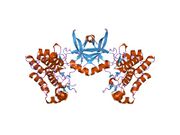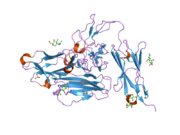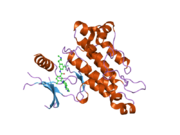Biology:TEK tyrosine kinase
 Generic protein structure example |
Angiopoietin-1 receptor also known as CD202B (cluster of differentiation 202B) is a protein that in humans is encoded by the TEK gene.[1][2] Also known as TIE2, it is an angiopoietin receptor.
Function
The TEK receptor tyrosine kinase is expressed almost exclusively in endothelial cells in mice, rats, and humans. (TEK is closely related to the TIE receptor tyrosine kinase.)[3]
This receptor possesses a unique extracellular domain containing 2 immunoglobulin-like loops separated by 3 epidermal growth factor-like repeats that are connected to 3 fibronectin type III-like repeats.[4] The ligand for the receptor is angiopoietin-1.[3] TEK has also been suggested as a marker for nucleus pulposus progenitor cells, from the intervertebral disc, which upon activation by Angiopoietin-1 starts to multiply and differentiate.[5][6]
Defects in TEK are associated with inherited venous malformations; the TEK signaling pathway appears to be critical for endothelial cell-smooth muscle cell communication in venous morphogenesis.[3]
In cancer patients, TEK (Tie2) is expressed in a subpopulation of monocytes that home in on the tumor and are essential for the formation of new blood vessels there.[7]
Interactions
TEK tyrosine kinase has been shown to interact with:
See also
- Tie-2/Ang-1 signaling
References
- ↑ "A novel endothelial cell surface receptor tyrosine kinase with extracellular epidermal growth factor homology domains". Molecular and Cellular Biology 12 (4): 1698–707. April 1992. doi:10.1128/mcb.12.4.1698. PMID 1312667.
- ↑ "Assignment of a locus for dominantly inherited venous malformations to chromosome 9p". Human Molecular Genetics 3 (9): 1583–7. September 1994. doi:10.1093/hmg/3.9.1583. PMID 7833915.
- ↑ 3.0 3.1 3.2 "Entrez Gene: TEK TEK tyrosine kinase, endothelial (venous malformations, multiple cutaneous and mucosal)". https://www.ncbi.nlm.nih.gov/sites/entrez?Db=gene&Cmd=ShowDetailView&TermToSearch=7010.
- ↑ 4.0 4.1 4.2 "Angiopoietin-1 and angiopoietin-2 share the same binding domains in the Tie-2 receptor involving the first Ig-like loop and the epidermal growth factor-like repeats". The Journal of Biological Chemistry 278 (3): 1721–7. January 2003. doi:10.1074/jbc.M208550200. PMID 12427764.
- ↑ "Exhaustion of nucleus pulposus progenitor cells with ageing and degeneration of the intervertebral disc". Nature Communications 3: 1264. 2012. doi:10.1038/ncomms2226. PMID 23232394. Bibcode: 2012NatCo...3.1264S.
- ↑ "Successful fishing for nucleus pulposus progenitor cells of the intervertebral disc across species". JOR Spine 1 (2): e1018. June 2018. doi:10.1002/jsp2.1018. PMID 31463445.
- ↑ "Identification of proangiogenic TIE2-expressing monocytes (TEMs) in human peripheral blood and cancer". Blood 109 (12): 5276–85. June 2007. doi:10.1182/blood-2006-10-053504. PMID 17327411. http://infoscience.epfl.ch/record/178135.
- ↑ 8.0 8.1 "Characterization of TEK receptor tyrosine kinase and its ligands, Angiopoietins, in human hematopoietic progenitor cells". International Immunology 10 (8): 1217–27. August 1998. doi:10.1093/intimm/10.8.1217. PMID 9723709.
- ↑ 9.0 9.1 "Angiopoietin-2, a natural antagonist for Tie2 that disrupts in vivo angiogenesis". Science 277 (5322): 55–60. July 1997. doi:10.1126/science.277.5322.55. PMID 9204896.
- ↑ "Isolation of angiopoietin-1, a ligand for the TIE2 receptor, by secretion-trap expression cloning". Cell 87 (7): 1161–9. December 1996. doi:10.1016/s0092-8674(00)81812-7. PMID 8980223.
- ↑ "The Tek/Tie2 receptor signals through a novel Dok-related docking protein, Dok-R". Oncogene 17 (9): 1097–108. September 1998. doi:10.1038/sj.onc.1202115. PMID 9764820.
- ↑ "Dok-R plays a pivotal role in angiopoietin-1-dependent cell migration through recruitment and activation of Pak". The EMBO Journal 20 (21): 5919–28. November 2001. doi:10.1093/emboj/20.21.5919. PMID 11689432.
Further reading
- "GRB2 and SH-PTP2: potentially important endothelial signaling molecules downstream of the TEK/TIE2 receptor tyrosine kinase". Oncogene 11 (10): 2097–103. November 1995. PMID 7478529.
- "Association of 75/80-kDa phosphoproteins and the tyrosine kinases Lyn, Fyn, and Lck with the B cell molecule CD20. Evidence against involvement of the cytoplasmic regions of CD20". The Journal of Biological Chemistry 270 (38): 22632–8. September 1995. doi:10.1074/jbc.270.38.22632. PMID 7545683.
- "A gene for familial venous malformations maps to chromosome 9p in a second large kindred". Journal of Medical Genetics 32 (3): 197–9. March 1995. doi:10.1136/jmg.32.3.197. PMID 7783168.
- "Isolation of novel and known genes from a human fetal cochlear cDNA library using subtractive hybridization and differential screening". Genomics 23 (1): 42–50. September 1994. doi:10.1006/geno.1994.1457. PMID 7829101.
- "Assignment of the endothelial-specific protein receptor tyrosine kinase gene (TEK) to human chromosome 9p21". Genomics 23 (2): 512–3. September 1994. doi:10.1006/geno.1994.1536. PMID 7835909.
- "Molecular cloning and characterization of a novel receptor protein tyrosine kinase from human placenta". Oncogene 8 (3): 663–70. March 1993. PMID 8382358.
- "Isolation of angiopoietin-1, a ligand for the TIE2 receptor, by secretion-trap expression cloning". Cell 87 (7): 1161–9. December 1996. doi:10.1016/S0092-8674(00)81812-7. PMID 8980223.
- "Requisite role of angiopoietin-1, a ligand for the TIE2 receptor, during embryonic angiogenesis". Cell 87 (7): 1171–80. December 1996. doi:10.1016/S0092-8674(00)81813-9. PMID 8980224.
- "Vascular dysmorphogenesis caused by an activating mutation in the receptor tyrosine kinase TIE2". Cell 87 (7): 1181–90. December 1996. doi:10.1016/S0092-8674(00)81814-0. PMID 8980225.
- "Chemotactic properties of angiopoietin-1 and -2, ligands for the endothelial-specific receptor tyrosine kinase Tie2". The Journal of Biological Chemistry 273 (29): 18514–21. July 1998. doi:10.1074/jbc.273.29.18514. PMID 9660821.
- "Tie2 receptor ligands, angiopoietin-1 and angiopoietin-2, modulate VEGF-induced postnatal neovascularization". Circulation Research 83 (3): 233–40. August 1998. doi:10.1161/01.res.83.3.233. PMID 9710115.
- "Characterization of TEK receptor tyrosine kinase and its ligands, Angiopoietins, in human hematopoietic progenitor cells". International Immunology 10 (8): 1217–27. August 1998. doi:10.1093/intimm/10.8.1217. PMID 9723709.
- "The Tek/Tie2 receptor signals through a novel Dok-related docking protein, Dok-R". Oncogene 17 (9): 1097–108. September 1998. doi:10.1038/sj.onc.1202115. PMID 9764820.
- "Socs1 binds to multiple signalling proteins and suppresses steel factor-dependent proliferation". The EMBO Journal 18 (4): 904–15. February 1999. doi:10.1093/emboj/18.4.904. PMID 10022833.
- "Angiopoietins 3 and 4: diverging gene counterparts in mice and humans". Proceedings of the National Academy of Sciences of the United States of America 96 (5): 1904–9. March 1999. doi:10.1073/pnas.96.5.1904. PMID 10051567. Bibcode: 1999PNAS...96.1904V.
- "Allelic and locus heterogeneity in inherited venous malformations". Human Molecular Genetics 8 (7): 1279–89. July 1999. doi:10.1093/hmg/8.7.1279. PMID 10369874.
- "Identification of Tek/Tie2 binding partners. Binding to a multifunctional docking site mediates cell survival and migration". The Journal of Biological Chemistry 274 (43): 30896–905. October 1999. doi:10.1074/jbc.274.43.30896. PMID 10521483.
- "Functional interaction of vascular endothelial-protein-tyrosine phosphatase with the angiopoietin receptor Tie-2". Oncogene 18 (43): 5948–53. October 1999. doi:10.1038/sj.onc.1202992. PMID 10557082.
External links
- GeneReviews/NCBI/NIH/UW entry on Multiple Cutaneous and Mucosal Venous Malformations
- Overview of all the structural information available in the PDB for UniProt: Q02763 (Angiopoietin-1 receptor) at the PDBe-KB.
This article incorporates text from the United States National Library of Medicine, which is in the public domain.
 |







